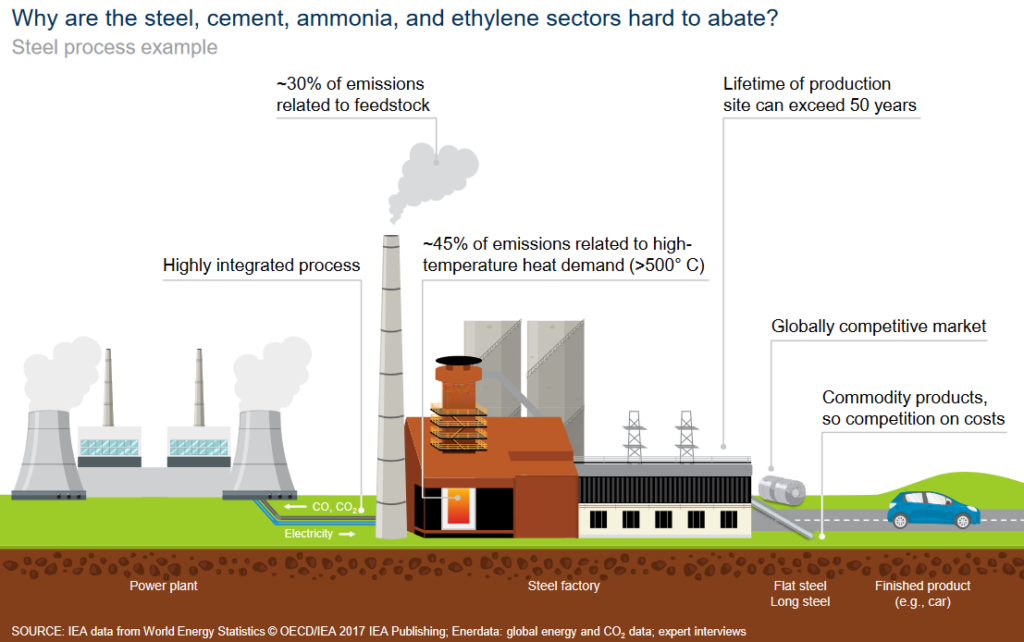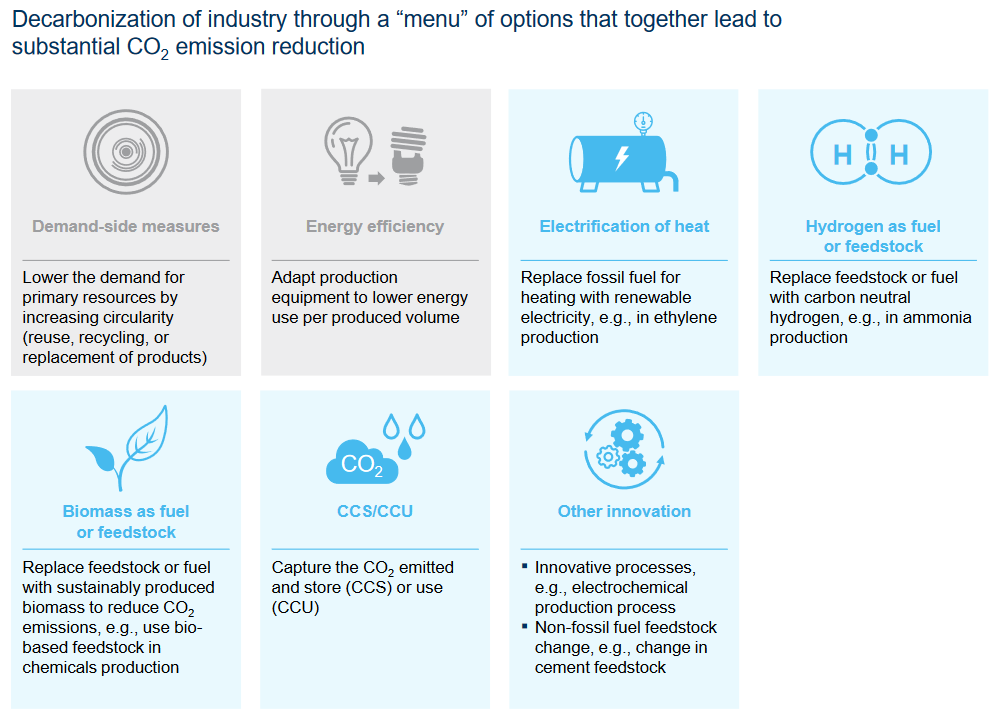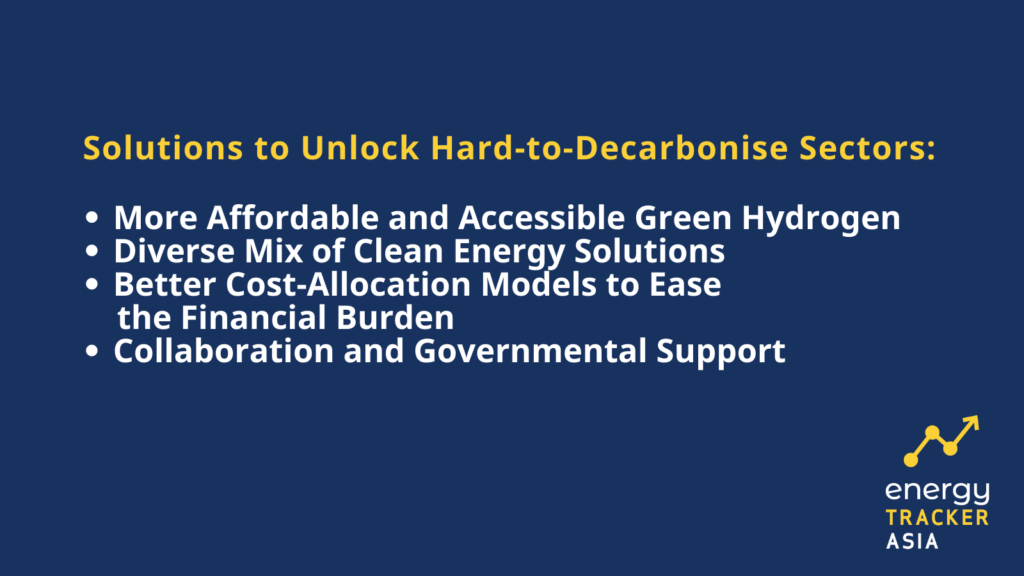Pathway to Zero Emissions for Hard-To-Decarbonise Industries
06 December 2021 – by Viktor Tachev
Transportation, steel, cement and chemicals are the foundation of our world and global economy. The reliance on them, paired with the fact that they are tough to decarbonise, is costly for the world’s net-zero aspirations. A pressing need exists to transform “hard-to-abate” sectors to meet the Paris Agreement targets. There is still change required, but the essential tools needed to fight climate change are already here to decarbonise these industries.
The Greenhouse Gas Emissions and Carbon Footprint of Hard-to-Decarbonise Industries
Collectively, transport sector – road, aviation and shipping – steel, cement and chemicals belch out 30% of carbon emissions globally. Of these, energy use in their respective industries holds the highest share.
Ammonia, cement, ethylene and steel are the greatest carbon dioxide contributors within the hard-to-abate industries and the culprits of global temperature rise. Worryingly, according to McKinsey, the global consulting firm, unless these industries can lower emissions, the globe will flounder the 80-95% greenhouse gas emissions reduction targets set by the Paris Agreement.

The Challenges – Is it Possible to Decarbonise Hard-to-Abate Industries?
There is an urgent need to decarbonise these industries, from fossil fuels to renewable fuels. However, not all sectors are equal, and rather than just a change in energy, the processes or production equipment need scrutinisation.
This is easier said than done. Many of these industries are highly integrated by nature, and most of the time, industrial processes and changes are challenging to apply. What’s more is that many production facilities are built with lifetimes that exceed 50 years, requiring costly retrofits.
The cost of removing emissions from these industries is also nothing to blow off—the estimated cost of this shift, between USD 11 and 21 trillion by 2050. Total decarbonisation would also require a boost in large-scale renewable energy capacity and expansion across the board. This also assumes essential changes in the vested interests of governments, institutions and industries in the current status quo.

Solutions to Unlock Hard-to-Decarbonise Sectors
Despite the challenges, hard-to-abate sectors could cut their emissions and develop broader business models through a combination of approaches.
More Affordable and Accessible Green Hydrogen – an Alternative to Fossil Fuels
In recent years, hydrogen energy has been experiencing unprecedented political and business momentum as an alternative energy source within hard-to-abate sectors. Yet, most hydrogen produced to date does not come from renewable energy sources but rather fossil fuels. This further adds carbon emissions instead of reducing them.
Green hydrogen based fuels, produced from renewables, is less than ideal due to high production costs. Yet this is changing. There are already developments underway to see green hydrogen prices plummet between USD 1 to 1.50 per kg by 2025. Some leading cement producers are already exploring hydrogen options to decarbonise their businesses.
COP26 and the Future of Hard-to-Abate Sectors in Asia
Read moreA Diverse Mix of Clean Energy Solutions
Diversifying the energy mix of hard-to-abate industries should also be ramped up. Wind, solar, hydro and green hydrogen all have roles to play. Other innovations would aid them within the sector, like carbon-neutral ammonia production and batteries and carbon capture improvements. Other concepts like “Power-to-X“, which redirects unused renewable grid energy to heavy industries, also show significant promise.

Better Cost-Allocation Models to Ease the Financial Burden
Due to the high upfront costs, industrial companies often hesitate to invest in the required clean energy manufacturing and carbon capture processes. Their burden can make companies less profitable in the short term.
More often than not, high upfront costs deter industrial companies from clean investments. It ultimately can affect their bottom line. However, industry reports and expert testimonies differ from this conventional wisdom. They suggest that costs passed on to consumers can work, with decarbonisation in hard-to-abate industries only costing 0.5% of global GDP by 2050.
Collaboration and Governmental Support
Governments can help too. Policy mechanisms like direct incentives for industrial companies, local and regional road maps and adjusting regulations can speed up industrial decarbonisation. Such measures are already in place in countries like Denmark. Its effort is an example of how focusing on energy efficiency and taxation can speed up industrial decarbonisation.
Like the Mission Possible Partnership, other initiatives aim to connect hard-to-abate industries with others like finance and policy. This, they hope, will move ambition toward decarbonisation efforts throughout the industry.
But time is of the essence. If decarbonisation is to speed up, policy support needs to extend over the entire innovation chain. This would be similar to the effort of culminating cost reduction and mainstream use of renewable energy. This kind of support would lend a hand to greater levels of innovation and scale to net-zero technology that could transform hard-to-abate industries.
Bottom Line
The decarbonisation of hard-to-abate industries is no longer wishful thinking but an increasingly realistic goal. Some say this could happen by mid-century. The means to transform exists, yet is there will to reach these once lofty goals.

by Viktor Tachev
Viktor has years of experience in financial markets and energy finance, working as a marketing consultant and content creator for leading institutions, NGOs, and tech startups. He is a regular contributor to knowledge hubs and magazines, tackling the latest trends in sustainability and green energy.
Read more